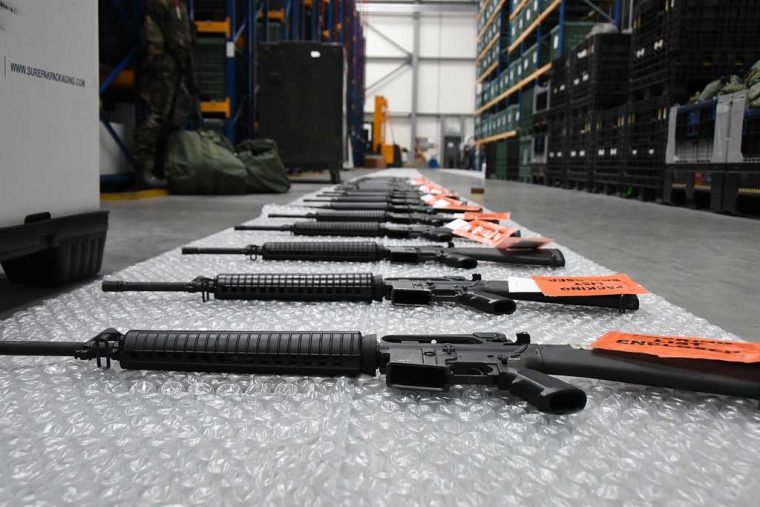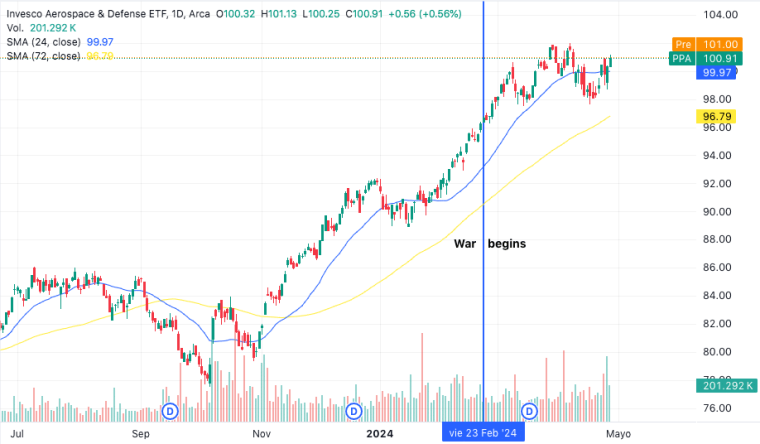After months of gridlock, the United States Congress has finally approved an unprecedented $95 billion military aid package for Ukraine, Israel, and Taiwan, providing a substantial boost to Kyiv’s efforts to fend off Russia’s invasion while fortifying the defenses of key allies.
The move, which President Joe Biden signed into law on Wednesday, promises a huge windfall for major US defense contractors and the military-industrial complex at large which is are already banking on these armed conflicts.
Securing this long-delayed assistance was quite a tough endeavor as bitterly divided members of Congress deadlocked over the funding bill for months.
House Speaker Mike Johnson ultimately rallied a Uniparty coalition to push the bill through while he managed to effectively overcome threats from his party members preparing to oust him. He ended up making the decisive vote, even though a majority of Republicans were against the bill.
Of the $95 billion package, a staggering $61 billion is earmarked for bolstering Ukraine’s military capabilities as it battles Russian forces.
The aid includes a wide range of munitions, including air defense systems, large quantities of artillery rounds – a commodity in high demand by Ukrainian troops – armored vehicles, and other vital weaponry.
Key Takeaways
- $95 Billion Military Aid Package Passed: Congress approved $95 billion in aid for Ukraine, Israel, and Taiwan, with $61 billion going to Ukraine for weapons and munitions.
- Defense Contractors Benefit: Lockheed Martin and RTX are expected to gain the most from new federal contracts, seeing a substantial business boost.
- Logistics Challenges: While some weapons will arrive quickly, others face delays. The Pentagon is improving logistics to speed up distribution.
- Stock Buybacks Criticized: Defense companies face scrutiny over large stock buybacks amid growing profits from war-related sales.
- Replenishing US Stockpiles: Part of the aid will rebuild US military supplies depleted from helping Ukraine.
- Long-Term Concerns: The defense sector may see short-term gains, but questions remain about future support, especially ahead of the 2024 elections.
Delivery Slowed as Pentagon Builds Robust Logistic Network

According to US officials, while some weapons will be rapidly transported to the battlefront – potentially within days – others may take longer.
The aid will be disbursed through the President’s drawdown authority, which allows for the rapid transfer of equipment and munitions from existing US stockpiles to Ukraine.
Also read: How Hackers Stole $50,000 of Yoghurt – Cargo Theft Skyrockets to $130M in 2023
Maj. Gen. Pat Ryder, the Pentagon’s press secretary, highlighted last week that they have adequate logistics to distribute the aid and that they are “doing everything we can to be poised to respond quickly”.
Since the Russia-Ukraine war started two years ago, the US has sent approximately $44 billion in military aid to the invaded European country to fight off the Russian offensive. Defense companies don’t usually book these sales until the equipment is delivered, meaning that the financial impact of this aid in their income statements will be evidenced within the next few months.
Investors, on the other hand, are already accounting for the tremendous windfall, pushing the top defense stocks up as it became more likely that the bill would pass.
The Windfall of a Life Time for Defense Giants
With more than $60 billion from the newly approved package expected to translate into new business over the next two to three years, major defense players like Lockheed Martin and RTX have emerged as the largest beneficiaries of $30 billion in federal contracts awarded to supply Ukraine and replenish US weapon stockpiles – are poised for a significant financial boost.
“Tactical and strike missiles are where we really saw a lot of sales activity”, Jay Malave, Lockheed’s Chief Financial Officer, told the Wall Street Journal. The company’s missiles unit reported a 16% increase in its revenue in the past quarter.
Since Russia invaded Ukraine in February 2022, Lockheed Martin’s stock has surged by nearly 13%, which is not necessarily a major increase in two years considering that the S&P 500 has rallied by nearly 21% during that same period.
However, it’s important to note that most of these defense stocks are generally very volatile and are heavily dependent on government contracts which can come and go often.
Meanwhile, RTX took the risk of expanding its capacity even after the Pentagon mentioned that the US financial aid to Ukraine was depleted as the company firmly believes that it can win further contracts valued at around $40 billion that will be specifically directed to the country led by Volodymyr Zelenskyy.
In the case of RTX, the stock has advanced by 10% since the armed conflict between the two nations started.
This isn’t a mind-blowing performance either, but the next few quarters, which will finally reflect the full financial impact of the aid, could be positive for both Lockheed Martin (LMT) and RTX if it turns out that their ability to profit from the situation was understated and they end up reporting above-expected results.
Companies in the defense sector like Lockheed and RTX have been subject to increasingly high levels of public and political scrutiny as they have collectively repurchased over $19 billion in stock last year, including $1 billion in the past quarter alone.
Critics point out that cronyism is quite common in lobbying for major defense contractors. Perhaps the most glaring element of the bureaucratic structure is the Secretary of Defense Executive Fellows (SDEF) program which sends promising officers to work for top US businesses, including many top defense companies.
The (supposed) idea is for these officers to gain experience and insight to use to improve the US military system but often these officers become mouthpieces for the company they worked for, often pushing to get them meetings and contracts. Later on, these officers are often offered extraordinarily lucrative jobs at the same businesses.
These corporate actions (and many others) have attracted criticism over how profits are soaring from higher weapons sales to the US military to supplement its aid packages.
A substantial portion of the package – over $20 billion – will be dedicated to replenishing US military stockpiles depleted by the transfer of weapons to Ukraine.
The US Army, for instance, plans to ramp up monthly production of 155mm artillery shells to 100,000 by next year, up from the current rate of around 40,000. This effort includes a new shell plant in Texas operated by General Dynamics.
“We are going to help Ukraine, but we have to help ourselves, too”, remarked Doug Bush, the Army’s acquisition chief, underscoring the dual purpose of the aid.
Defense Companies Face Scrutiny Amid Soaring Profits and Buybacks
Lawmakers and military officials like Navy Secretary Carlos Del Toro have voiced their concern about a practice deemed by them as “war profiteering”.
“You can’t be asking for the American taxpayer to make greater public investments while you continue to goose your stock prices through stock buybacks, deferring promised capital investments, and other accounting maneuvers”, Del Toro said at an industry conference in January.
Also read: Disney Announces Panicked $3 Billion Buyback and 50% Dividend Increase as Activist Threats Loom
Defense companies benefitting from the Russia-Ukraine war have emphasized that although these sales do generate profits for their shareholders, they have also ramped up their manufacturing capacity and continue to invest heavily in upending their facilities to keep up with the demand.
“I don’t see one being made at the expense of the other,” Lockheed’s Malave commented. In 2024, Malave’s company will be spending $1 extra billion in capital expenditures to reach a total of $10 billion in critical infrastructure investments to expand the company’s installed capacity.
Aid Packages Provide Temporary Boost to Defense Stocks
Stocks within the defense sector have been gaining ground this year as showcased by the Invesco Aerospace & Defense ETF (PPA), which has seen its value increase by 9.5% since the year started compared to the 7.7% gains seen by the S&P 500 index during that same period.
As demand for military hardware surges, defense contractors are scrambling to expand their production capacity. Swedish firm Saab, a major supplier to Ukraine via the aid provided by their local government, has invested billions to boost capacity, expanding its workforce by 3,600 since the start of 2022 while they have plans in place to add another 2,000 employees this year.
“I have been so long with this company, and I have never seen anything like this in terms of boosting capacity”, Micael Johansson, Saab’s Chief Executive Officer, told CNN in February. His company reported a 30% increase in its net profits last year.
How Long Will This Last?
Defense companies are sitting pretty at the moment, salivating at the incoming sales, but this may be their last windfall in a little while.
While the latest aid package is expected to sustain the defense industry for about a year, questions linger about how long the US can provide this kind of support for Ukraine, especially now that the 2024 presidential elections are approaching.
Donald Trump, the presumptive Republican nominee, has railed against providing further aid, softening his stance only as momentum grew for the supplemental bill.
As the conflict drags on, Ukraine faces the difficult task of prioritizing its immediate needs while simultaneously preparing for a broader offensive to try to reclaim territory seized by Russian forces.
With 18% of Ukrainian land under Russian control according to the latest reports from the United Nations (UN), a major counterattack would demand a well-resourced campaign in terms of soldiers, equipment, and munitions.
The defense industry appears poised for a prolonged boom, driven by both an escalation in the tensions between the US and China and Russia’s ongoing effort to conquer Ukraine and annex its territory.
“The great power competition is largely the driver of where spending is going, and that is predicated on the rise of China and the continued negative influence of Russia’s engagements in Europe”, Myles Walton, a defense analyst at Wolfe Research, told CNN.
As hostilities continue to surge in various corners of the world, the defense sector’s fortunes seem inextricably linked to the global security challenges and the latest aid package could serve as a potent catalyst for further growth and profitability.

